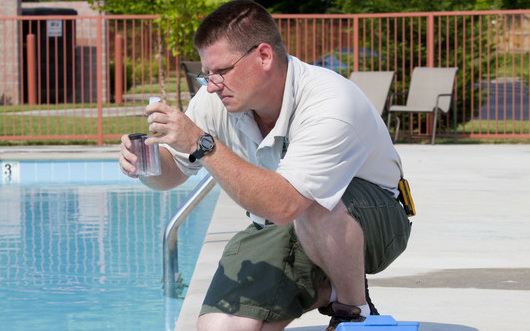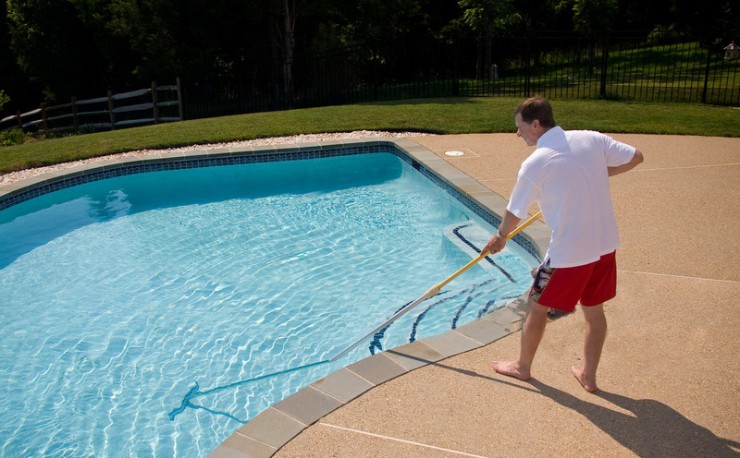High phosphates are bad for swimming pools for a couple of reasons: they indirectly cause the chlorine to deplete, which could lead to a green pool, and they are a food source for algae. Fortunately, high phosphate levels are not too common and are easy to lower. Let’s see how to do it.
Article Contents
Equipment & Chemicals to Remove Phosphates
- Phosphate test kit
- Chemical phosphate remover
- Pool brush
- Pool vacuum
How To Lower & Remove Phosphates in Pool Water
It’s important to know that phosphates will never be removed from your pool water. The good news is that high phosphate levels are easy to treat and easy to maintain.
Phosphates fall into two categories, organic and inorganic. Organic phosphates come from natural sources such as decomposing vegetation, soil, and rocks. Inorganic phosphates most commonly come from detergents and fertilizers.
Step 1:Test for phosphates

If you test for phosphates once per month, you’ll likely have phosphates under control, and they won’t be an issue. However, if you notice your pool starting to cloud or turn green, test for phosphates and treat, if necessary. Phosphates are food for algae, and allowing them to get out of control will turn into a bigger and more costly problem than it needs to be.
You can learn how to test for phosphates in our article. In short, you can use a home test kit. They generally aren’t as accurate as testing at a pool store.
What Should Phosphate Levels Be?
Before you attempt to reduce phosphates, be aware that phosphates are really only an issue once they reach 500 ppb (parts per billion), and that usually takes a while. I recommend testing for high phosphate levels once per month to stay on the safe side or whenever there has been heavy fertilization or rain near your pool. Fertilizer runoff is a common cause of high phosphates.
Step 2: Brush and Vacuum the Pool

If you have high phosphate levels (above 500 PPB), you will likely be at the beginning stages of an algae bloom. Brush and vacuum the pool before adding a phosphate remover to eliminate any possible algae sediment in the water.
Step 3: Add a Phosphate Remover
Many phosphate treatments are on the market, but they all lower phosphates with salts from metals (see below). I’ve only used one because it has always worked well and is Natural Chemistry Phosfree. This isn’t to say it’s the best, but it has always worked for me.
- Maintains near zero phosphate levels
- Cleans waterline and filter
- Reduces surface oils and other non-living organics
Step 4: Retest the water
Anytime you balance a pool’s chemicals, you should retest to ensure you are in range. If you are retesting phosphate levels, waiting 24-48 hours before retesting is okay.
How to Use Phosphate Removers
Similar to painting, adding phosphate remover is easy, but the prep work is important. Make sure the pool and the filter are clean, and your other chemicals are balanced.
Next, follow the directions on the side of the phosphate remover bottle and add it to your pool. Retest the levels in 24-48 hours to ensure that the levels are within range.
When using, the ideal range of phosphates is less than 200 ppb, but anything below 500 ppb is fine. Use enough products to get to these levels. Again, high phosphates will not cause an immediate problem with your water, but they will throw your other chemical levels off and provide a food source for algae, which is never good.
How to Choose a Product to Remove or Control Phosphates
Phosphate removers get rid of phosphates by aluminum or lanthanum salts which, when added to water, produce insoluble compounds that can be filtered out. The first information you need to know before buying a phosphate remover is how high your numbers are because different phosphate removers have different strengths.
Just like with all pool chemicals, the size of the pool is a major factor in determining how much phosphate remover you will need. If you have a high level of phosphates, I recommend Aqua Doc Maximum Strength phosphate remover.
- Fast-acting
- Enhances water clarity
- Ultimate growth control of unwanted organisms
How Much Phosphate Remover Do You Need?
The easiest way to discuss how much phosphate remover you need is by looking at a chart. All pool chemicals measurements are determined using a base scale of 10,000 gallons (38,000 litres). That is, the amount of phosphate remover to use will be an amount per 10K gallons of pool water.
The difference with phosphate removers is that the level of phosphates also plays a role in how much phosphate remover to add. Different manufacturers have different dosage suggestions, but this chart from Orenda Technologies is a good example.
| 0-500 ppb | 2 fl oz. (59 mL) |
| 500-1,000 ppb | 4 fl oz. (118 mL) |
| 1,000-2,000 ppb | 8 ppb (237 mL) |
| 2,000 or higher | 10 oz (473 mL) |
Phosphate Removal FAQs
How Long Does it Take to Remove Phosphates From A Pool?
Removing phosphates from a pool is a straightforward process, and it takes 24-48 hours to remove them after adding a phosphate remover. After 48 hours, test the levels again to see if phosphates are below 500 ppb. If they are still above this, you add more phosphate remover.
What Causes High Phosphate Levels in a Pool?
Phosphates are organic materials naturally occurring from many sources like fertilizers, detergents, dirt, leaves, and other organic materials.
Will Phosphate Remover Kill Algae?
Phosphate removers do not directly kill algae. People often confuse phosphate removers with algaecides, although they are very different. In this context, consider phosphate removers an algae preventative agent and algaecide an algae killer.
Since algae feed off phosphates, keeping the levels below 500 ppb will eliminate the food source. But, because your phosphate levels are low, you can still get algae for many reasons. If this is the case, you must use shock and algaecide to kill the algae.
Is Swimming In A Pool With High Phosphates Unhealthy?
High phosphates in a pool are not harmful to swimmers. Chances are, you’ve already swam in a pool with high phosphates. The only time high phosphates are unhealthy to swim in is when the collection has turned green from algae.
Tips to Prevent or Lower Phosphates in Pool
The best way to control and prevent high levels of phosphates in your pool is to monitor the levels monthly. You can either do this with a home kit or take a sample of your pool water to a reputable pool supply store.
Here are some other tips:
- Ask bathers to rinse off before swimming in your pool
- Prevent rain runoff from entering the water (if possible)
- Remove organic debris, such as leaves and twigs, as soon as possible
- Prevent fertilizer runoff from entering your pool



